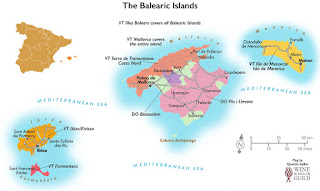 |
| The Balearic Islands (Source: Wikipedia) |
But wines are also made there, with Mallorca, the largest of the islands, the source of one of the Cutting Edge Wines so designated by Wines from Spain. I report on that wine --AN/2 -- in this post.
Winemaking in the Balearic Islands has a very long history, a history which was upended, as was the case for many in Europe, by the onset of the Phylloxera debacle. The ravages of the French vineyards meant that they had to look to other sources for fruit; and grape-growing in the Balearics expanded rapidly to meet this new demand. Balearic Island vineyards were decimated when the louse made landfall in the islands in 1891, causing a widespread shift to non-vine agricultural crops among the growers.
Even the resolution of the phylloxera issue did not result in a return to grape-growing in the Balearics; instead, grapes were grown only for local consumption. In the 1990s, however, a number of local winemakers decided to improve the quality of wine produced in the islands (Catavino) and, in furtherance of that goal: planted international varieties to complement the local varieties; enhanced irrigation systems; and introduced stainless steel and oak barrels for fermentation and aging.
Grapes are grown on all three of the Balearic Islands but the most vinously significant is Mallorca. The chart below shows the distribution of appellations among the islands and illustrates that the only regional DOs are in Mallorca.
Of relevance, given the wine that we are evaluating, is the fact that VT Mallorca covers wine made at any place on the island.
The map below shows the location of Anima Negra, the producer of AN/2, just outside the town of Felinatx.
The winery was founded in 1994 by Pere Obrador and Miguelàngel Cerdá. It currently owns 70 ha of vineyards and controls the fruit from 30 ha of old vines owned by local growers. These dry-farmed vineyards adhere to biodynamic practices.
AN/2 is a blend of old-vine Callet (65%), Mantonegra-Fogoneu (20%), and Syrah (15%). The grapes were manually harvested and placed into 10-kg boxes fro transport to the winery where they were manually and optically selected on the sorting table.
The grapes were fermented by indigenous yeasts in stainless steel tanks and then macerated for 17 days. Post-maceration, the wine was transferred to barrels (80% French barriques, 20% American oak) for a year's worth of aging (The barrels are 35% new, with the remainder being between one and three vintages old.). The wine is then aged for an additional 6 months in bottle before release onto the market.
The 2017 wine showed red fruit, spice, baking spice and a tree-bark, resinated character on the nose. Broad and unfocused. Easy-drinking on the palate. Simple. Fruity and brambly. The least favorite of the wines I tasted on this day.
©Wine -- Mise en abyme



No comments:
Post a Comment